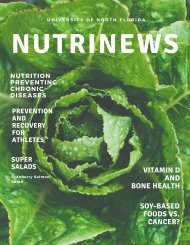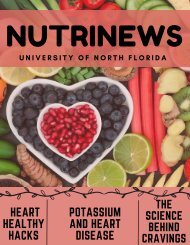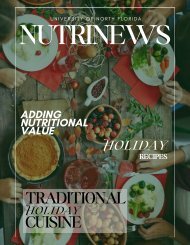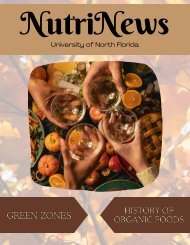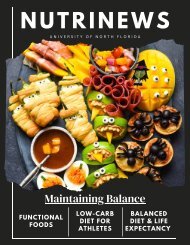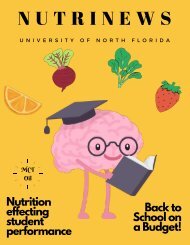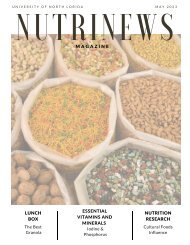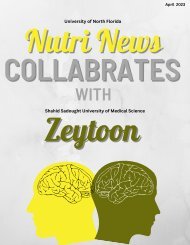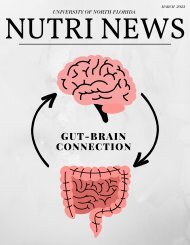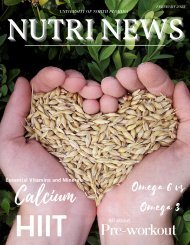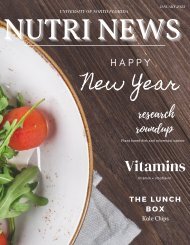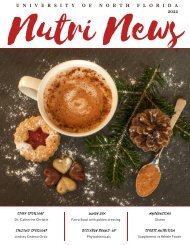March Issue
Hello everyone, I want to wish everyone a happy National Nutrition Month! Nutrition Services has a ton of events planned this month so make sure to check those out on the COVID Corner collum and UNF website. The issue features Emily Carlile, who is a senior in the nutrition program, as this month’s student spotlight. We also wanted to put a light on arugula with some in-season info, and tips on how to make a delicious arugula pasta dish. I also want to thank everyone apart of the Nutrinews team. This would not be possible without every single one of you. Sincerely, Emily Henley Editor in Chief
Hello everyone,
I want to wish everyone a happy National Nutrition Month! Nutrition Services has a ton of events planned this month so make sure to check those out on the COVID Corner collum and UNF website. The issue features Emily Carlile, who is a senior in the nutrition program, as this month’s student spotlight. We also wanted to put a light on arugula with some in-season info, and tips on how to make a delicious arugula pasta dish. I also want to thank everyone apart of the Nutrinews team. This would not be possible without every single one of you.
Sincerely,
Emily Henley
Editor in Chief
You also want an ePaper? Increase the reach of your titles
YUMPU automatically turns print PDFs into web optimized ePapers that Google loves.
UNF NUTRINEWS
The Department of Nutrition and Dietetics
MARCH 2021
COVER PHOTO DESIGNED AND TAKEN BY PAYTON TURNER
“Students are dealing with an unprecedented amount
of stress and worry. We do not want eating to be an
additional stressor in the midst of this social media
era where there is so much misinformation about
nutrition and overall wellbeing. We will be
completing our certification in Intuitive Eating
Counselors to help people make peace with food and
create a healthy relationship with eating, mind, and
body.”
Even though COVID has interrupted our daily lives, our university has
done well to adapt quickly. Hopefully, we are on a path that leads to
human interactions. In the meantime, we will all have to visit each other
in the virtual world. Be mindful of participating in mental health and
self-care practices.
Stay safe, Ospreys!
3
Research Around The World
By Melissa Brennan
March 16th is National Artichoke Day. It is quite
fitting for this vegetable to have its own day as it is
packed with nutrients and antioxidants.
Artichokes are a good source of nutrients, such as
vitamin C, folate, magnesium, fiber, and
phytonutrients.1 In celebration of National
Artichoke Day, here is some interesting research
regarding the beneficial effects of artichoke leaf
extract (ALE) through supplementation.
Rondanelli, et al. set out to evaluate the effects of
two months of supplementation of ALE (250 mg
twice a day) on cytokine levels (inflammation
response), natural killer cell response (immune
response), and metabolic profiles (looking at blood
lipids and insulin resistance).2 In this single group,
pretest-posttest quasi-experimental design all
participants received the supplementation with no
control group. The study had 9 male and 11 female
participants with an average age of 49 years. All
subjects followed a personalized isocaloric energy
diet that was set up by a registered dietitian. This
means each caloric goal was set per individual with
the goal of maintaining weight. The supplement
was given before lunch and before dinner
throughout the 60-day period of the study. After
supplementation, a significant increase in HDL
cholesterol and total cholesterol/HDL ratio was
found, as well as a decrease in natural killer cell
response. Therefore, it was concluded that ALE
supplementation can have a favorable effect on
blood lipids and an overall metabolic profile,
specifically in individuals with low HDL and
hypercholesterolemia.
References:
1. Health and nutrition. Artichokes.org. http://artichokes.org/recipes-andsuch/health-and-nutrition.
Accessed February 2, 2021.
2. Rondanelli M, Castellazzi AM, Riva A, et al. Natural killer response and lipometabolic
profile in adults with low HDL-cholesterol and mild
hypercholesterolemia: beneficial effects of artichoke leaf extract supplementation.
Evid Based Complement Alternat Med. 2019;2019:9. doi:10.1155/2019/2069701
4
Shopping in Season:
Arugula
B Y : C A M E R O N G L O V E R
Arugula is a leafy green that packs a big flavor.
Like most leafy greens, arugula is almost entirely
Unlike popular salad greens like romaine lettuce or
composed of water with very little carbohydrates
iceberg lettuce that have a subtle, watery flavor,
and fats, as well as little calories. A low-calorie,
arugula’s taste is best described as peppery,
nutritious, and flavorful green that pairs well with
spicy, and sometimes even bitter.
One way to
almost any pasta dish is a miracle for people who
avoid too much bitterness is by using baby arugula
love “unhealthy” Italian food.
rather than the larger, more mature leaves. Many
As far as grocery shopping goes, arugula is easy
people interpret peppery and bitter flavors as
to find and affordable. Almost any grocery store
negative characteristics, but adding arugula to a
will have arugula, either by itself or in many
fresh salad gives it a brighter taste than you would
different salad mixes, such as the most common
find in a plain salad mix. Since arugula was first
Spring Mix. A container with 5 oz of baby arugula
cultivated in the Mediterranean, it is most often
from Walmart will cost about $2.50, and the same
paired with Italian dishes, like pasta or, my
size container from Target is $3.99. At Publix, the
personal favorite, pizza. The flavor works well with
mature arugula is only $2.19, but the baby arugula
cheeses like parmesan or feta, making it easy to
is a little pricier at $3.43. Luckily, a little can go a
incorporate into any of your favorite pasta dishes.
long way with arugula because it is often mixed
It is worth adding especially because of the many
with other types of lettuce when used in salad. As
nutrients it contains with very little added calorie
for hot dishes with arugula, it does cook down
arugula is a particularly great source of Vitamin K,
quite a bit, but the strong flavor it has means that
Folate, and Vitamin C. One 3.5 oz serving provides
you likely won’t need much to taste it. Arugula’s
a whopping 103% of the DV for Vitamin K, which
helps prevent blood from clotting and strengthen
bones.
bright green color will help make your dishes pop,
and it is worth experimenting with while it is the
cheapest this month.
5
7
Nutrition Reviews medical journal reviewed
studies based on self-selected diets identified
through surveys and 10 epidemiological
studies which tested the sustainability of the
self-selected diets. Nutrition Reviews synopsis
of examined studies included information
from Tackling Climate Change through
Livestock. The information provided through
this book includes an overview of average
GHGEs by species, with cattle being at the top
of the list. Statistics from the book state that
cattle are responsible for 65% of the livestock
sector emissions. The book also specifies that
production of milk from cattle is responsible
for a lower percentage of greenhouse gas
than the cattle raised for beef consumption.
Studies validated this finding by suggesting
that even vegetarian diets which include
consumption of dairy are a step in the right
direction for sustainability. Additionally, this
book provides information on mitigation
policies for managing livestock in a manner
that will reduce environmental impact. This is
an important consideration because from a
socioeconomic standpoint, it is not feasible
for some cultures to adopt a primarily meatfree
diet.
Another source of information for
Nutrition Reviews article is from a study
conducted in the United Kingdom by the
European Prospective Investigation into
Cancer and Nutrition (EPIC). This study
implemented a diet referred to as the
Dietary Approaches to Stop Hypertension,
or DASH. The results of this cross sectional
study indicated that a diet indicating plant
based foods such as vegetables and whole
grains significantly reduces both GHGE’s
and risk of hypertension. The downside to
the DASH implementation is that it was
proven to be more costly than alternative
diets.
9
While this synopsis of Nutrition Reviews
article only provides a brief overview of
what is involved in determining a
sustainable diet, the unanimous
conclusion of the reviewed studies
indicates that production of crops
required to feed livestock and the
consumption of meat itself are both
responsible for significant GHGEs.
Reducing production and
consumption of meat products can
benefit the environment by lowering the
amount of GHGEs and can aid in lowering
the average mortality rate as well. While
there is a strong correlation between
vegetarian diets and improved health, it
is critical to choose the correct
substitutions for meat replacement to
ensure adequate nutrition standards are
being met. In addition, it is possible to
receive the same sustainable benefits by
reducing meat consumption without
removing it entirely from a diet, which
can be the most cost efficient method in
some cases.
References:
1.Perignon M, Vieux F, Soler LG, Masset G, Darmon N. Improving diet sustainability through evolution of food choices: review of
epidemiological studies on the environmental impact of diets. Nutr Rev. 2017;75(1):2-17. doi:10.1093/nutrit/nuw043
2. Gerber PJ, Steinfeld H, Henderson B, et al. Tackling Climate Change Through Livestock. Rome, Italy: Food and Agriculture Organization
of the United Nations; 2013.
3. Monsivais P, Scarborough P, Lloyd T, Mizdrak A, Luben R, Mulligan AA, Wareham NJ, Woodcock J. Greater accordance with the Dietary
Approaches to Stop Hypertension dietary pattern is associated with lower diet-related greenhouse gas production but higher dietary costs
in the United Kingdom. Am J Clin Nutr. 2015 Jul;102(1):138-45. doi: 10.3945/ajcn.114.090639. Epub 2015 Apr 29. PMID: 25926505; PMCID:
PMC4480663.
10
Student
Spotlight
INTERVIEW BY KARLA GUERRA
Hey everyone, meet Emily Carlile, a Senior in
the nutrition and dietetics program. Born and
raised in Jacksonville, Florida, Emily works for
a functional medicine clinic in Ponte Vedra
Beach as an office assistant. She is the Vice
President for the Student Nutrition and
Dietetics Association, a volunteer for a
registered dietitian at a private practice where
she makes social media posts, handouts for
clients, and blog articles. Emily played various
sports such as tennis, volleyball, soccer,
competitive cheerleading, and took dance
classes. Emily loves going to Disney World
and Disneyland, and she is a Tea enthusiast
with love for plants and flowers. Read along to
learn more about Emily and her journey as a
nutrition and dietetics student at UNF.
11
KG: What activities or hobbies do you
enjoy doing outside of school?
EC: A few hobbies that I enjoy doing
outside of school are hiking, gardening,
trying new recipes, going to the beach in
the summertime, practicing yoga, playing
the piano, watching Netflix (Gilmore Girls
is my all-time favorite show), exploring
new places, and learning new things.
KG: What advice would you give
to incoming students entering
the nutrition program?
EC: A piece of advice I would give to
incoming students entering the
nutrition program is to get involved
on campus. Whether that be
volunteering, joining a club, or
partaking in research opportunities.
This is a great way to build
relationships with your peers and
professors.
KG: What has been a memorable
moment for you as a student in the
nutrition program?
EC: A memorable moment for me as a
student in the nutrition program was going
to legislative day last February. It felt so
invigorating and powerful to walk in with
other nutrition students and our
professors to speak to senators and
congressmen who were unaware of the
nutrition and dietetics profession. It felt
good to know that I was helping make a
difference not just for myself but for others
in our field and for anyone who needs
nutrition services.
KG: What has been your
favorite class in the Nutrition
and Dietetics Program?
EC: My favorite class in the nutrition
and dietetics program has been
Advanced Nutrition Science. I really
enjoyed learning how we digest and
absorb our food through our
bodies' various processes. Even
though it was a challenging class, I
learned so much that I will take with
me throughout my career.
12
your cup up "Fill
before you first
KG: What plans and goals do you have
after graduation?
EC: After graduation, I plan to start a
master's program in the fall with a
functional nutrition concentration. Then
complete the required internship and sit
for the RD exam to become a registered
dietitian. My long term goal is to have my
own private practice one day that caters to
womens’ health conditions and pregnancy.
KG: Do you have a study tip or
hack that you must follow to
help you succeed during
school?
EC: A hack that I must follow to
help me succeed during school is
getting a planner to stay
organized. With a full class
schedule and extracurriculars, it's
so easy to forget due dates or
times of events. During the first
week of every semester, I write out
all the dates of assignments,
exams, and projects. It's a simple
hack but makes a world of
difference.
KG: Do you have a favorite inspiring quote or mantra that you live by and
would like to share with others?
EC: A quote that I live by is,
fill others"
This quote reminds me that I can't pour from an empty cup, so I need to take care of
my mind and body first before I can overflow into the lives of others.
13
14
5 W A Y S T O H A N D L E A
C H A L L E N G I N G A C A D E M I C
S E M E S T E R
By: Tamara Marsh
Sometimes, college can be stressful. Luckily, there are many ways to deal with
how you’re feeling. Below are 5 ways to handle a challenging academic
semester.
1
2
Take a break.
Take a day off or a few hours
away from doing any
academic work. This will give
you time to rest, relax, and
clear your mind. Engage in a
relaxing activity or a fun
hobby such as meditating,
listening to music, painting,
drawing, watching a funny
show or movie, or catching up
with a friend or loved one.
Incorporate rest and
relaxation into your daily
schedule to avoid feeling
overwhelmed, burnt out, and
stressed.
If necessary, consider taking
a semester or a year break
from school if your health is
interfering with grades, you
are dealing with a financial
or family crisis, you’re
unsure why you are in
college, or need take break
to focus on something else.
Consult your academic
advisor on how a break will
affect your graduation date.
If you are unsure if taking a
break from school is the best
decision for you, you can talk
to a UNF counselor.
Established and maintain a
healthy lifestyle.
Healthy habits are usually set
aside when dealing with stress.
Stress can trigger unhealthy
behaviors such as emotional
eating, skipping meals and
workouts, sleeping less or too
much, alcohol or drug use, and
social isolation. Regularly
exercising, eating balanced
meals, sleeping, and socializing
are great ways to combat stress
and important to maintain your
health.
15
3
4
Utilize campus resources.
Write down what you are struggling with this
semester and create a plan to overcome these
challenges. You can also make an appointment
with a persistent advocate to help you
create a plan. Other campus resources to utilize
include office hours offered by your professors
and tutors for academic support. An academic
coaching session is available for students to
learn how to succeed in college by learning about
various topics such as time management, notetaking,
study skills, and public speaking. If you
would like to attend or learn more about UNF’s
tutoring or coaching services, visit your
MyWings page, click “Academic Support”, and
then click the service you are interested in.
Reduce non-academic
commitments.
Non-academic activities can interfere
with your academic commitments. If
possible, reduce your non-academic
commitments for the semester or until
you can balance both academic and
non-academic activities.
You can reduce the amount of time you
participate in your non-academic
activities or take a break. This will allow
you to allocate more time to the class or
classes you are struggling in. You will
have more time to complete your
assignments, attend tutoring sessions,
and study for exams and quizzes.
5
Withdraw from a course.
As a last resort, you can withdraw from your
course if the withdrawal deadline has not
passed. There may be financial and academic
consequences. The best way to know what
the consequences are is to speak to your
academic advisor and a financial aid
representative. If you have completed most
of your coursework, you could ask your
professor for an incomplete grade.
16
§ Garlic – 2 cloves
§ Shelled walnuts – 2 tablespoons
§ Arugula – ½ cup
§ Basil – ½ cup
§ Salt – ¼ teaspoons
§ Pepper – to taste
§ Olive oil – 1/3 cup
§ Parmesan cheese – 1/3 cup
§ Rotini pasta – 2 ½ cups
In either a food processor or a mortar and
1.
grind down the cloves of garlic into a paste.
pestle,
Boil water for the rotini, adding salt if desired.
7.
it starts to bubble, add the pasta, and cook
Once
Set aside a scoopful of pasta water and strain
8.
rest. the
Integrate the reserved pasta water with the
9.
and cooked pasta.
pesto
Ingredients
Steps
2. Incorporate the walnuts and continue to blend.
3. Once combined, add arugula, salt, and pepper.
4. Pour olive oil into the mix and continue to blend.
5. Mush the parmesan into the mixture.
6. Once the pesto is complete, set aside.
until al dente (5-7 minutes).
18
1. Shulman MR. Arugula Pesto. The New York Times. https://cooking.nytimes.com/recipes/1014013-arugula-pesto. Accessed February 1, 2021.
*Nutrition information obtained from a label in the grocery store.
10. Top with extra parmesan and enjoy!
National
Nutrition Month
E A T Y O U R
F R U I T S
Strawberries, blueberries,
apples, pears, melons and
oranges
F I L L H A L F
Y O U R
P L A T E
W I T H
V E G G I E S
Carrots, kale, brussel sprouts
squash, califlower, beets and
corn
E A T A
V A R I E T Y O F
W H O L E
G R A I N S
Brown rice, oatmeal, quinoa
buckwheat, whole grain pasta
and corn
19
20
Meet The Staff
Emily Henley
Editor in Chief
Anna Waterman
Co Editor in Chief
Aishwarya Patel
Head Publisher
Dr. Alireza Jahan-
Mihan
Faculty Advisor
Contact Us: UNFNutriNews
@gmail.com
21
Meet The Staff
Kyla Cooper
Editor
Dalila Mumic
Editor
Allison Barfieild
Editor
Anita Diaz
Public Relations Manger
Contact Us: UNFNutriNews
@gmail.com
22
Meet The Staff
Ronesia Willson
Public Relations
Website Manager
Maris Meza
Publisher
Anna McQueen
Publisher
Cristina Reyes
Publisher
Contact Us: UNFNutriNews
@gmail.com
23
Meet The Staff
Atalia Vazquez
Treasurer
Kathryn Griffiths
Flyer Designer
Payton Turner
Photographer
Contact Us: UNFNutriNews
@gmail.com
24





